Pope John Paul II
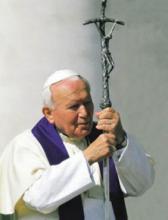
Popes John Paul II and John XXIII will be formally declared saints on April 27, 2014, the Vatican said Monday. Pope Francis made the announcement during a meeting with cardinals gathered in Rome.
John Paul, who was pope from 1978 to 2005, and John, who reigned from 1958 to 1963, are considered two of the most influential religious leaders in the world in the last century, and they represent two poles in Roman Catholicism — John XXIII is a hero to liberals, while John Paul II is widely hailed by conservatives.
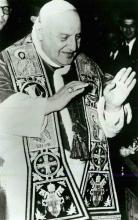
When the Vatican announced this month that Pope Francis would formally elevate Popes John Paul II and John XXIII to sainthood, two things stood out.
For John Paul, it was the record speed that he reached sainthood, just eight years after his death. The only other saint to be canonized so quickly in modern times was Opus Dei founder Josemaria Escriva, whose sainthood bid took 27 years.
But for John XXIII, Francis decided to waive the church law that requires a second miracle in order to be named a saint. Asked how John XXIII could be named a saint without the required second miracle, the Vatican’s chief spokesman said “no one doubts his virtues.”

Pope Francis declared on Friday that Popes John Paul II and John XXIII will be made saints, elevating the two most decisive popes of the 20th century to the pantheon of Catholic life and worship.
In a sign of the worldwide devotion for John XXIII, known as “Good Pope John,” Francis waived the requirement for a second miracle credited to John XXIII’s intercession, with the Vatican’s spokesman saying, “no one doubts his virtues.”
Francis signed off on a decree recognizing the second miracle attributed to the Polish-born John Paul II, who reigned from 1978 to 2005 , and is credited with globalizing the papacy and playing a key role in the downfall of the communist regimes of Eastern Europe.
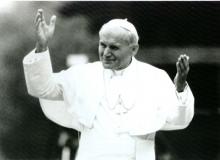
Reports this week that the late Pope John Paul II may be on the verge of sainthood after a second miracle was credited to his intercession aren’t a huge surprise: When he died eight years ago, crowds were already clamoring for his canonization, and Pope Benedict XVI quickly waived the usual five-year waiting period to get the process rolling.
But the news that Pope Francis, just six weeks on the job, has cleared the way for the long-stalled canonization of martyred Salvadoran Archbishop Oscar Romero is a stunner that sends another important signal about the new pope’s priorities.
“Sainthood is often as much about politics and image as anything else,” said the Rev. Harvey Egan, a Jesuit priest and professor emeritus of theology at Boston College.
“It’s not surprising to me that this present pope being from South America, having the same inclinations as Romero, would unblock the process and say ‘Push his cause through,’ and I think rightly so.”
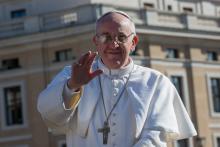
He has been Pope Francis for less than a month, but the keep-it-simple prelate from Argentina is a wow with American Catholics — at least for now.
The tables may turn on Francis once media attention moves from his no-fuss style to his substantive actions, said a Vatican expert Wednesday.
The former archbishop of Buenos Aires has an 84 percent favorable rating among U.S. Catholics, including 43 percent who hold a very favorable view of him, according to a new survey by the Pew Forum on Religion & Public Life.
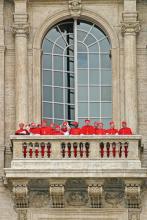
“In the church,” Chicago Cardinal Francis George once said, “everything has happened at least once!” That’s no surprise given that the Catholic Church is a nearly 2,000-year-old institution that has adapted to radically different epochs.
But electing a new pope while the former pope is still alive? That’s rare.
So what are some other firsts and lasts, quirks and facts of papal history that you should know? There are plenty, and Religion News Service has compiled a handy guide.
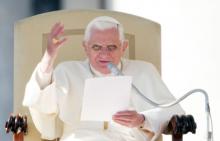
When Cardinal Joseph Ratzinger was elected Pope Benedict XVI in 2005, the surprising choice cast a pall over the liberal wing of the flock and left conservatives giddy with the prospect of total victory. Ratzinger had for decades served as the Vatican’s guardian of orthodoxy, the man known as “God’s Rottweiler,” and his vocal fans were crowing about the glorious reign to come.
“He’ll correct the lackadaisical attitudes that have been able to creep into the lives of Catholics,” the Rev. M. Price Oswalt, an Oklahoma City priest who was in St. Peter’s Square that April day, told The New York Times. “He’s going to have a German mentality of leadership: either get on the train or get off the track. He will not put up with rebellious children.”
Now, however, with Benedict set to leave office eight years later in an unprecedented departure, many on the Catholic right are counting up the ways that Benedict failed them, and wondering how their favorite watchdog turned into a papal pussycat.
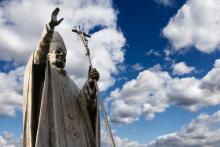
VATICAN CITY — Pope Paul VI, who guided the Catholic Church through a tumultuous period of change in the 1960s and 70s, took a crucial first step toward possible sainthood when Pope Benedict XVI last week recognized his predecessor’s “heroic virtues.”
Paul VI is now considered “venerable” in the Catholic Church, and needs the Vatican to recognize a miracle due to his intercession in order to be beatified, or declared “blessed.” A second miracle would then elevate him to sainthood.
Giovanni Battista Montini (1897-1978) was elected to the papacy with the name of Paul VI in 1963. He oversaw the implementation of the modernizing reforms of the Second Vatican Council (1962-1965).
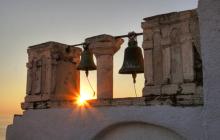
Our text this morning, brothers and sisters, is from the inimitable Scottish devout Robert Louis Stevenson, writing (ostensibly) about his native city:
“Indeed, there are not many uproars in this world more dismal than that of the Sabbath bells in Edinburgh: a harsh ecclesial tocsin; the outcry of incongruous orthodoxies, calling on every separate conventicler to put up a protest, each in his own synagogue, against ‘right-hand extremes and left-hand defections.’ And surely there are few worse extremes than this extremity of zeal; and few more deplorable defections than this disloyalty to Christian love. Shakespeare wrote a comedy of ‘Much Ado About Nothing.’ The Scottish nation made a fantastic tragedy on the same subject. And it is for the success of this remarkable piece that these bells are sounded every Sabbath morning on the hills above the Forth. How many of them might rest silent in the steeple, how many of those ugly churches might be demolished and turned once more into useful building materials, if people who think almost exactly the same thoughts about religion would condescend to worship God under the same roof! But there are the chalk lines. And which to pocket pride, and speak the foremost word?”
Which, indeed?
Let us talk for a minute, blunt and honest and not polite for a change, about that which is never said and ought to be: that the divisions and disagreements among the Christian sects and traditions are silly and selfish.
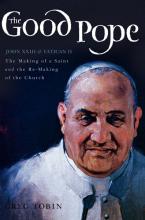
Fifty years after Pope John XXIII convened the Second Vatican Council that revolutionized the Catholic Church, will the jolly man known as the "Good Pope" be declared a saint of the Roman Catholic Church? Perhaps the better question is: Should he be?
On the evening of June 3, 1963, John XXIII passed into eternity with his family, doctors and household staff present in the papal apartments where he had lived for four and a half years. The Vatican press office issued this terse statement: “He suffers no more.”
Immediately, there was a movement by some close to the deceased pope to have him canonized by acclamation, as saints had been during the early centuries of the church. The first session of the Second Vatican Council (1962-65) had ended in December 1962, and the pope had published his landmark encyclical letter,Pacem in Terris (Peace on Earth) in April 1963.
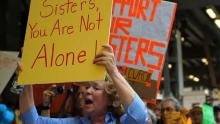
Fifty years after Pope John XXIII convened the Second Vatican Council to modernize the Roman Catholic Church, the legacy of that watershed summit that revolutionized Catholic life is at the core of a dispute between the Vatican and American nuns.
In April, the Vatican accused the Leadership Conference of Women Religious (LCWR), the umbrella group that represents the majority of American nuns, of “doctrinal confusion.” As LCWR leaders meet this week (Aug. 7-11) to plot their response to the Vatican, many of the sisters say they are just following the spirit of Vatican II.
“This is not just about the Vatican versus the nuns. This really is about the future of how we interpret the message of the Second Vatican Council,” Sister Maureen Fiedler told the PBS program “Religion & Ethics NewsWeekly.”
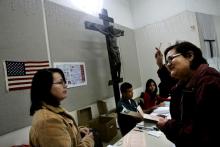
A group of Democratic-leaning Catholics on Wednesday (Feb. 29) released a 2012 voter guide that seeks to expand the concept of "pro-life issues" beyond abortion to also include war, euthanasia and poverty.
The nine-page guide from the group Catholics in Alliance for the Common Good — one of the first to be released for the 2012 elections — highlights economic issues as top concerns Catholics should weigh as they consider their vote.
The guide is markedly different from others circulated by conservative Catholic groups, which stress opposition to abortion rights as a non-negotiable stance for American Catholics.
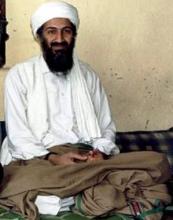
Each year, members of the Religion Newswriters Association, the world’s premier association dedicated to helping journalists write about religion, vote on what they believe are the top religion stories of the year.
This year, more than 300 religion journalists cast their ballots in an online survey conducted Dec. 10-13, choosing the death of Osama bin Laden on May 2 in a covert operation in Pakistan by U.S. Navy SEALs and CIA operatives ordered by President Barack Obama as the top story of 2011.
See the complete list of RNA's top religion stories of the year inside.

The Catholic church is reeling from the several sexual abuse allegations that have come to light over the past three months. Downplaying the severity of this scandal will only further damage the already beleaguered church's image and credibility. Many in the media blame Pope Benedict XVI for the mismanagement of the sexual abuse crisis.